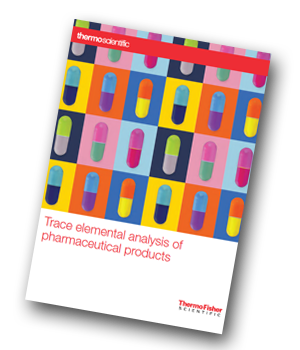This useful compendium from Thermo Fisher provides detailed methods for the analysis of trace elements in pharmaceutical products using AAS, ICP-OES and ICP-MS covered by the NEW USP chapters 232 and 233.
 Elemental impurities in pharmaceutical formulations can interfere with drug efficacy or have a toxic effect on the patient. Regulators have issued guidelines — such as ICH Q3D, USP 232 and USP 233 Elemental Impurities — for monitoring a range of metal elemental impurities in pharmaceutical materials using inductively coupled plasma (ICP), optical emission spectroscopy (ICP-OES), or mass spectrometry (ICP-MS). In addition, alternative techniques such as atomic absorption spectroscopy (AAS) can be used if specific validation requirements described in the guidelines are met.
Elemental impurities in pharmaceutical formulations can interfere with drug efficacy or have a toxic effect on the patient. Regulators have issued guidelines — such as ICH Q3D, USP 232 and USP 233 Elemental Impurities — for monitoring a range of metal elemental impurities in pharmaceutical materials using inductively coupled plasma (ICP), optical emission spectroscopy (ICP-OES), or mass spectrometry (ICP-MS). In addition, alternative techniques such as atomic absorption spectroscopy (AAS) can be used if specific validation requirements described in the guidelines are met.
The specific applications covered within this compendium include:
Analysis by AAS
- Using graphite furnace atomic absorption to meet the requirements of elemental impurity analysis in pharmaceutical products for arsenic, cadmium and lead
- Using cold vapor generation atomic absorption to determine mercury impurities in pharmaceutical products
Analysis by ICP-OES
- Analysis of elemental impurities in drug products using the Thermo Scientific iCAP 7400 ICP-OES Duo
- Analysis of trace elements in Traditional Chinese Medicine (TCM)
- Analysis of trace elements in nutraceuticals in compliance with USP chapter <2232> Elemental Contaminants in Dietary Supplements
Analysis by ICP-MS
- Analysis of pharmaceutical products for their elemental impurities with the Thermo Scientific iCAP RQ ICP-MS
- The determination of elemental impurities in vitamin B12 supplements using the Thermo Scientific iCAP TQ ICP-MS




